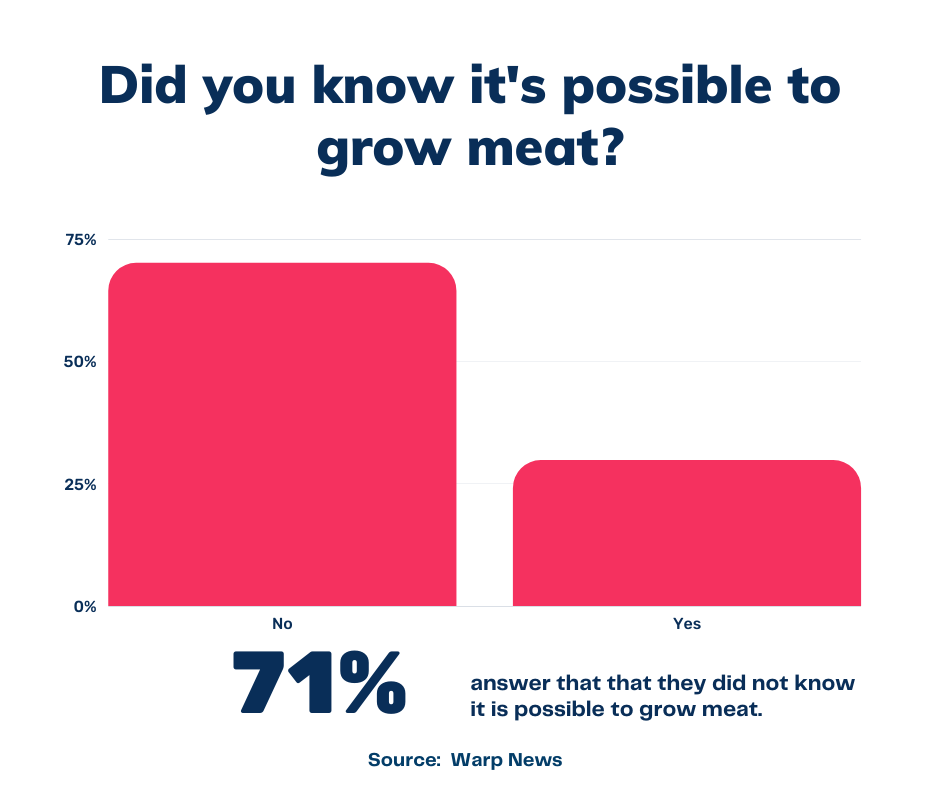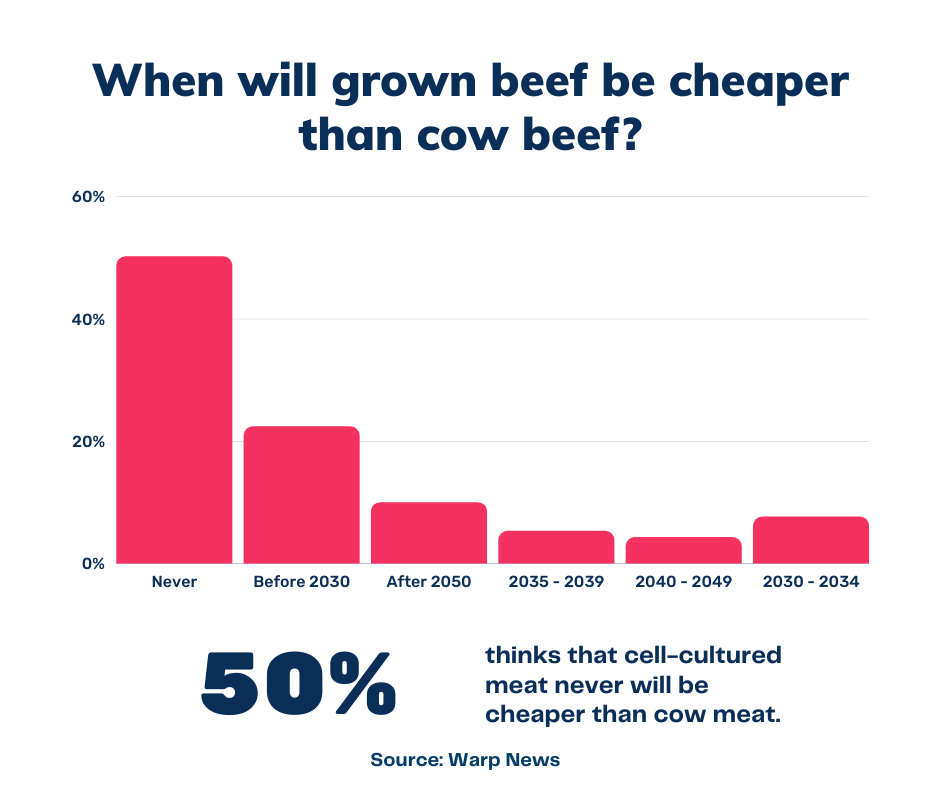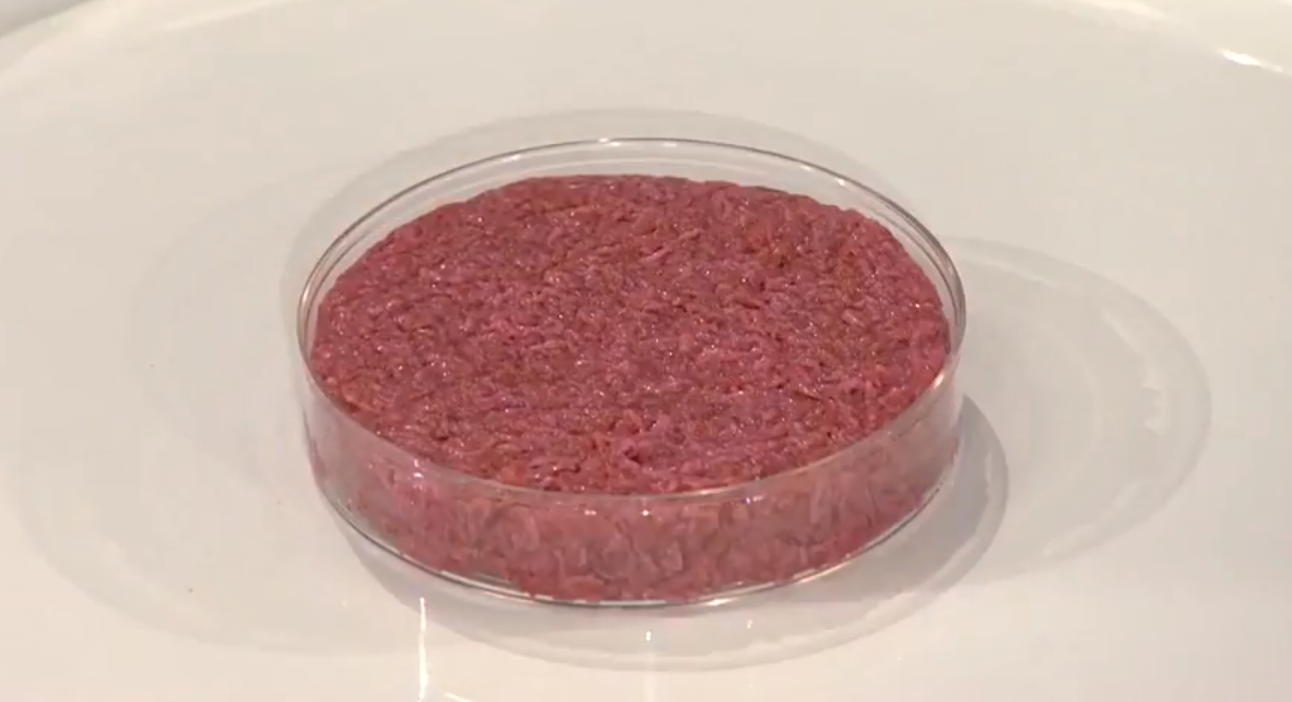
💡 Optimist's Edge: Cell-grown burgers will be cheaper than cow-grown burgers
Cell-grown means that it is real meat, but not from a dead cow. Most people are wrong about how quickly the price of such meat will fall. Here is everything you need to know about the development of cultured meat, so that you can get a (juicy) edge.
Share this story!
Summary
📉 What people are wrong about
70 percent of the respondents in our survey are not aware that it is possible to grow meat in bioreactors.
More than half of the people that answered our survey do not believe that cell-cultured meat will ever be cheaper than meat from livestock. A majority is wrong about how the price development will look for cell-based meat in the coming decade.
📈 Here are the facts
The first cell-cultured meat was presented as early as 2013 and, since the end of 2020, it is possible to buy cell-cultured meat in a restaurant. Producers have shown cell-cultured beef, cell-cultured chicken, and cell-cultured salmon fillets.
The cost of producing cell-cultured meat is dropping very fast, even faster than the cost of transistors.
There are a lot of investments in start-ups operating in cell-cultured meat. There is a great need to find climate-friendly alternatives to the conventional meat and dairy industry, which puts a very heavy strain on the planet.
💡 Optimist’s Edge
An increasingly efficient and scaled-up production - combined with a continued increase in demand for alternative protein sources - will very likely make a hamburger cooked from cell-cultured ground beef cheaper to buy than a hamburger from livestock sourced ground beef as early as 2027.
Cell-cultured meat contributes to significantly reduced carbon dioxide emissions, a decrease in the use of fresh water and land areas, and a reduced need for deforestation.
Cell-cultured meat can be tailored and optimized from a health standpoint and can be grown without using hazardous chemicals and without using antibiotics or growth steroids.
👇 This is how you get the Optimist’s Edge
Make local restaurants and the media aware of the developments, and make sure your local politicians understand the benefits of cell-cultured meat. This is likely to help accelerate both industry demand and legislation that needs to be put in place.
More and more companies are starting in the cell-based meat business.
Pick some interesting companies to readmore about to get an idea about investment opportunities – or make yourself familiar with the equipment and infrastructure needed in the industry. That will give you an edge when development accelerates even more.

📉 What people are wrong about
70 percent of the respondents in our survey are not aware that it is possible to grow meat in bioreactors. Most of these people probably eat meat often but still have no idea that this product can be produced completely without the enormous resources required to raise cows.

More than half do not believe that cell-cultured meat will ever be cheaper than meat from livestock. Most people who guess a year are wrong with a 20-year margin...
A majority is wrong about the price development for cell-cultured meat in the coming decade.

📈 Facts about cell-cultured meat
The Food and Agriculture Organization of the United Nations (FAO) has forecasted that global consumption of animal meat will increase by 73 percent by 2050 and that consumption of dairy products will increase by 58 percent over the same period.
Unfortunately, our planet is already under heavy pressure from the meat industry – today almost 80 percent of the world's farmland is used for grazing and raising livestock. Just over 60 percent of the land area is used for beef production, despite the fact that beef accounts for less than 2 percent of the calories consumed in the world.
In addition to large landmasses, cattle require enormous amounts of food and water. Furthermore, the global industry of animal protein production accounts for 14.5 percent of the world's greenhouse gas emissions, while also being one of the main causes for a significant share of the annual deforestation in the world.

"There is an urgent need for more efficient and sustainable production methods in the food industry. And cell-cultured meat will be a very important key component," says Warp News Food-Tech expert Daniel Skavén Ruben.
At the end of 2020, the first commercial cell-cultured meat was sold in a restaurant in Singapore in the form of chicken nuggets from the US company Eat Just.
But the first cell-cultured hamburger was created as early as 2013. But at that time the cost of producing it was $325,000. Back then, cell-cultured meat was hardly viewed as a realistic everyday protein source. However, eight years have passed, and the progress in technology in this field has accelerated rapidly. The tech is already in place that would allow a strong expansion and scaled-up production.
The Dutch producer Mosa Meat, whose founder, Dr. Mark Post, developed the above-mentioned super expensive premiere burger in 2013, projects that they will be able to offer their burgers for just $10.90 in a few years.
Israeli Future Meat Technologies says they can deliver meat for just over $21.50 per kilo by 2022.
In mid-May 2021, Future Meat Technologies also announced that they had succeeded in reducing its production costs by almost 50 percent, which means that it is now possible to create 110 grams of cell-cultured chicken breast for less than $4. A cost that is predicted to be halved again, to less than $2 over the next 12-18 months.

Calculations have been made which, with the help of Moore's Law, compare the price development for cell-cultured meat with the price development for the most advanced technology. The calculations showed that the price drop for cell-cultured meat since 2013 is steeper than the corresponding fall in prices for transistors.
Since the first cell-cultured hamburger was introduced in 2013, the cost of producing it has dropped by 6,000 times.
Another report that analyzed data from 16 companies active in producing cell-cultured meat, concludes that at least cell-cultured ground beef may be down to the same price level as ground beef from cows before 2030.
The interest from the food industry and other players – and thus also investments – has also increased. And not only costs have dropped, the amount of time required to grow meat from cells has been reduced extensively and is now down to two weeks for some producers. At the same time, production methods have been developed that are fit for industrial scale.
All in all, this means that the price of cell-cultured meat can be reduced to an affordable level that the market will accept and, as demand and production increase, prices will fall to the same levels as meat from livestock.
"In the next few years, we will see more and more cell-based meat both in restaurants and on grocery store shelves" says Daniel Skavén Ruben.
💡Optimist’s Edge
The increasingly efficient production methods combined with increased demand from consumers will be the driving force behind price reduction, and that's why it's safe to say with high probability that a cell-cultured ground beef burger will be cheaper than a hamburger made with meat from cows as early as 2027.
Acceptance of – and demand for – alternative protein sources has increased sharply in recent decades, partly due to health reasons and the meat industry's treatment of animals, and partly due to the industry's major negative impact on the climate and environment. A report predicts that as much as 60 percent of all the meat we eat by 2040 will not come from dead animals. In the UK alone, sales of vegan alternatives increased by 40 percent between 2015-2019. This has, of course, meant that the prices of these products have fallen steadily.
A reduced proportion of animal meat in people's diets, in favor of a higher proportion of cell-cultured meat will contribute significantly to reducing the carbon emissions in the world. In comparison with the breeding of livestock, cell cultivation of meat takes up considerably less land area and demands lesser amounts of water and emits much less greenhouse gases.
A study shows that cell-cultured meat uses land area 60 to 300 percent more efficiently than chicken production and 2,000 to 4,000 percent more efficiently than beef. According to several studies, cell-based chicken meat would take up 35-67 percent less space, while cell-cultured beef reduces the need for land area by at least 95 percent.
The Good Food Institute (GFI) exemplifies this by saying that an acre of farmland in Iowa is sufficient for the production of 453 kilos of chicken meat each year. The same acre would enable the production of up to 1,588 kilos of cell-cultured chicken meat.

All in all, cell cultivation of meat would thus make it possible to both meet a growing demand for animal protein and greatly reduce the need for deforestation to make room for crops.
If these large amounts of land could be freed up, it could be used for planting forests.
"Cell-based meat also does not require the enormous amounts of antibiotics used by the meat industry, which contributes to increased antibiotic resistance, and it contains no other contaminants. In addition, cell-based meat of course means that animals do not have to suffer to become human food. Another advantage is that cell-based meat can be tailored to be as healthy as possible with, for example, lower fat content or healthier fatty acids, or adapted for those who need to improve their cholesterol levels," Warp News Food-Tech expert, Daniel Skavén Ruben explains.
With all these factors and driving forces in mind, we can draw the conclusion that cell-based meat will be a part of our everyday meals in a surprisingly short time.
👇 This is how you get the Optimist’s Edge
If you are not willing to completely give up conventional meat today, there is some good news for you. In just a few years you can buy cell-cultured meat in your local store and it will be used in beef-based products such as burgers and meatballs, not to mention various types of chicken dishes.
Cell-cultured meat is a good choice not only for your health and the climate – but also for your wallet.
As more and more people realize the benefits of cell-cultured meat and make it a natural part of their diet, prices will continue to fall as production costs fall and competition for consumers intensifies. The large-scale production of animal meat products, which inevitably has a negative impact on the climate and animal welfare, will be considered both unnecessary and unsustainable on the scale it exists today.

In recent years, large numbers of new companies active in cell cultivation of meat and vegan alternatives have been started around the world. In addition, investments in cell-cultured meat have increased – in 2019, twelve start-ups received a total of $50 million in investments, doubling the figure compared to the previous year.
Investors and advocates include well-known names such as entrepreneur Richard Branson, Bill Gates and Google co-founder Sergey Brin. According to a forecast, the global market for cell-cultured meat is estimated at $214 million in 2025 and $593 million in 2032.
The strong growth will be boosted by more and more start-ups entering the market due to the growing number of large investors. What you can do today is to spread the message that cell cultivation of meat is by no means a distant future scenario – the fact is that the technology is in place and the production could quite easily be scaled up when legislation allows it and consumers and shops demand it (already today, as we have described, you can go into a restaurant in Singapore and order entirely cell-based meat).
If you want the future to come sooner, you can work to ensure that both your country and your local shop or restaurant are at the forefront of development.
Both entrepreneurs and investors have the potential to gain both returns and reputation by becoming part of the global transition to sustainable, cell-cultured meat products. The cell-cultured meat industry represents a sustainable and innovative opportunity and will be a great driving force in phasing out the many unsustainable and unethical ways in the meat industry.
It does not have to be about starting or investing directly in companies that cell-cultivate the meat; there are great opportunities to, as they say: "sell shovels during a gold rush".
Therefore, find out what the enablers are and what peripherals are needed, from plants and machines to biochemical substances, packaging materials, storage solutions and much more.
In the future, we will probably see how exclusive varieties of cell-based meat are being served in restaurants, while budget types will be available in all grocery stores. There are simply many incentives to invest in the cell-based meat market.
You now have an edge because you have gained this knowledge before most others – what will you do with your Optimist's Edge?
❓ What more can you do?
Please share more ideas with your fellow Premium Supporters in our Facebook group.
🤔 Want to know how the cell-cultured meat are made – check this video out!
Note: The survey was conducted on 500 respondents using Google Surveys.
Note: Claims in this article do not constitute financial or investment advice. Always do your own research before investing.
By becoming a premium supporter, you help in the creation and sharing of fact-based optimistic news all over the world.


